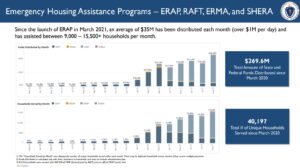
Massachusetts has distributed almost $270 million in emergency rental assistance funding to more than 40,000 households since March 2020, according to figures the Baker administration published Friday. Courtesy image / Screenshot
Exactly 11 months after the state’s pandemic-inspired moratorium on evictions expired, Baker administration and judiciary officials touted the effort to connect renters and landlords with emergency aid as a model of success even as advocates and lawmakers contended that the system still has harmful gaps.
Top deputies to Gov. Charlie Baker and court leaders said they feel confident that the Bay State’s response is working well to keep vulnerable residents housed, particularly after some housing activists and lawmakers warned that U.S. Supreme Court’s Aug. 26 ruling lifting a federal eviction moratorium would exacerbate the strain.
Massachusetts has significantly ramped up its distribution of rental aid in recent months and has implemented changes to streamline the process, the officials said Friday, adding that the state is on pace to clear a major federal benchmark that could result in additional dollars heading to the Bay State.
“We certainly understand and recognize there’s been a lot of ongoing concerns among renters and landlords impacted by the COVID-19 pandemic, especially in light of recent actions by the Supreme Court on the CDC moratorium,” said Housing and Economic Development Secretary Mike Kennealy. “There’s a lot of national stories and national coverage on the topic, and we frankly don’t believe the national headlines are an accurate depiction of what’s happening here in Massachusetts.”
Massachusetts has distributed nearly $270 million in emergency housing assistance to more than 40,000 unique households since March 2020, according to data the administration presented Friday.
The pace has been accelerating since late last year, too. In December, the state distributed $4.1 million in rental aid to 1,363 households; by August, the monthly total reached $46 million and 15,644 households, officials said. The release of funds in August was more than twice as much as the $20 million annual budget the Residential Assistance for Families in Transition Program had before the pandemic.
On Track to Hit Key Benchmark
Officials said Massachusetts is likely to achieve an important benchmark by the end of the month.
The Consolidated Appropriations Act former President Donald Trump signed in December, which awarded the first major batch of federal emergency rental aid, requires states to spend or obligate at least 65 percent of the funding by Sept. 30. Any state that fails to meet that target could have the remainder of its funding reclaimed by the U.S. Treasury and reallocated to another state that succeeded.
As of Sept. 10, officials said, Massachusetts had spent or obligated $266.5 million from its first batch of Emergency Rental Assistance funding. That represents 61 percent of the initial pot, just 4 percentage points short of the end-of-month goal.
Department of Housing and Community Development Chief of Programs Amy Stitley called that “a really good position to take other funds should they become available.”
Changes Mean Aid ‘Hitting Its Stride’
Since January, the administration has been operating a rental application processing center and has automatically income-qualified all verified MassHealth and Department of Transitional Assistance applicants for rental aid.
Those changes “allowed the state to really hit its stride” in March, said DHCD Undersecretary Jennifer Maddox.
Today, applicants need four major documents to seek emergency housing assistance: an identification for the head of household; proof of residence, such as a lease; verification that they face a housing crisis, such as a court summons for an eviction; and verification of income, which for most applicants already happens via MassHealth or DTA.
“We think we’ve hit a really nice balance of program integrity and getting aid out fast,” Stitely said.
Program Still Has Gaps
However, some attorneys who work with tenants facing eviction and lawmakers who have pushed for a more sweeping response do not share the administration’s sense of pride in the diversion initiative.
Molly Broderick, an attorney in the housing unit at Greater Boston Legal Services, said the administration has implemented “some productive changes, especially in the last month,” but that the program overall is “still not where it needs to be.”
“Here in Massachusetts, we’re still seeing the money is really, really hard to access. Maybe more people are getting access to it than in June, but in June, the majority of applications for rental assistance were getting rejected,” Broderick told the News Service. “Just because it’s gotten better doesn’t mean that it’s enough.”
Baker and lawmakers allowed the state’s eviction moratorium to expire in October 2020. The administration and court officials instead launched a diversion initiative designed to connect landlords and tenants to emergency aid, mediation, and legal help.
Since the state moratorium lifted, about 14,700 new eviction cases for failure to pay rent have been filed in Massachusetts, according to Trial Court data.
Officials said Friday that the state processed 16,774 applications from the week of July 5 through the week of Aug. 23. Sixty percent of those were approved, 7 percent were denied and 33 percent timed out, they said.
Time-outs typically occur when an applicant or landlord has not provided enough information or responded to outreach, and DHCD gives each candidate a 14-day period to reopen their application after it expires. Officials said about 20 percent of applicants take that opportunity, and that half of those who reapply get approved for aid.
Admin Plans More Staff
DHCD plans to bulk up staffing at its rental application processing center, provide clearer instructions, and conduct door-knocking campaigns to reduce the impact of expired applications, officials said.
Of the 18,500 households served between March and August, almost 60 percent were extremely low-income, 40 percent identified as Hispanic or Latino, 29 percent identified as Black, and 69 percent had a woman head of household, according to administration data presented Friday.
Advocates and lawmakers continue to push for legislation that would reinstitute a state-level temporary ban on evictions and foreclosures, require landlords to exhaust all rental assistance options before seeking an eviction, and order additional streamlining to the aid application process.
“We can have gratitude and appreciation for all of the public servants who are working to respond to the need for rental assistance, but my take, and this is based on both interactions with constituents as well as feedback from front-line advocates, is that the system is working decently for people who have representation but not working so well or working well at all for underrepresented individuals or for people who are trying to access the system cold,” Rep. Mike Connolly, a Cambridge Democrat who has backed that legislation, said in an interview.
A pandemic-era law requires courts to freeze all eviction cases while an application for rental aid is pending, but Trial Court Chief Justice Paula Carey said Friday that any eviction case will still go on a tenant’s legal record even if proceedings are paused.
Broderick warned that unless the state can keep cases out of court in the first place, tenants will still face lasting consequences even if they receive rental aid.
“The second that someone has an eviction case against them, it goes on their record, and we know statistically it can really get in the way of finding housing in the future,” Broderick said.






